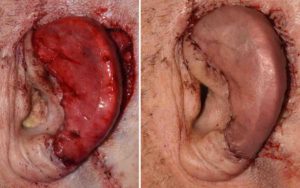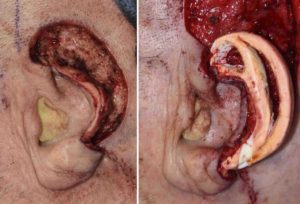Ear reconstruction for partially or completely removed/lost ears in adults must take into consideration the needed soft tissue coverage. While the cartilage of the ear can be replaced by either a synthetic framework or rib cartilage, it requires vascularized tissue and a skin graft to have a reconstruction result that survives and hopefully looks good. Contrary to the understandable perception of some patients, you can’t just put a skin graft directly on cartilage or a synthetic material.
In most cases of major ear reconstruction, the key element is what is known as a TPF flap. This stands for a temporoparietal fascial flap. Fed its blood supply by the ascending superficial temporal artery passing in front of the ear, this is the fascial layers (excluding the deep fascia) overlying the temporal muscle on the side of the head. This thin tissue can be raised off the entire temporal muscle and turned down to cover a synthetic or cartilage ear framework. It is onto this tissue that a skin graft can then be placed to complete the third layer of the reconstruction.

When seen at three months after surgery, the ear looks more defined and some of the details of the framework can finally be seen. While it will never look exactly like what was removed, it creates an acceptable looking result.
The long-term aesthetic outcome of ear reconstruction awaits the contraction of the thin overlying vascularized tissues to adapt to the framework. This ‘shrink wrap’ effect is a process that takes months after the surgery to reveal its full effects.
Dr. Barry Eppley
Indianapolis, Indiana



